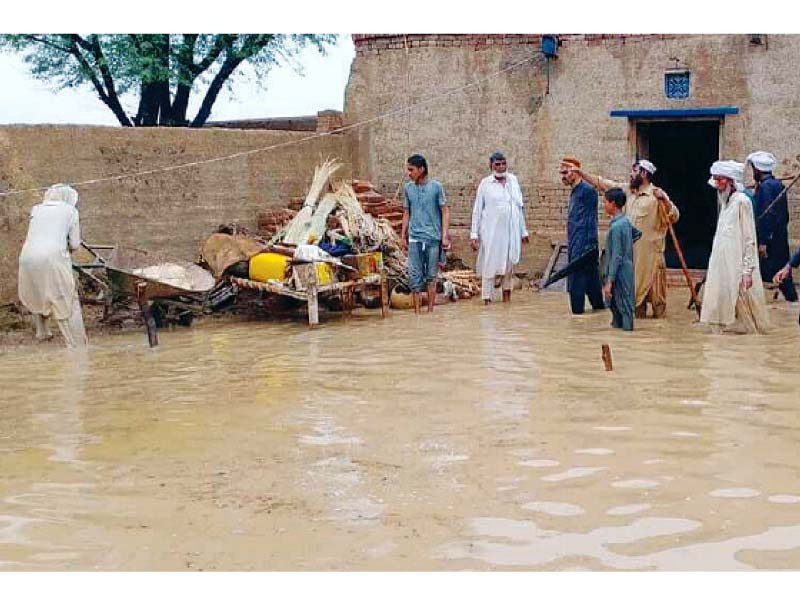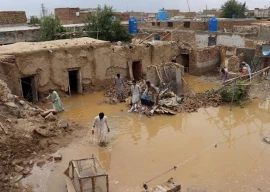
Several global financial institutions announced on Thursday immediate assistance of more than $500 million after Prime Minister Shehbaz Sharif issued an appeal for helping the flood victims in several parts of the country.
Heavy rains and floods this monsoon season have left hundreds of people dead, washed away houses, standing crops, roads, bridges, disconnecting land routes and causing hindrance in the relief operations across the country.
While urging emergency cooperation, the prime minister “appealed” to the international financial institutions, organisations, and countries that they should provide resources so that the flood-affected people could be reached and helped at the earliest.
In response, World Bank Country Director Najy Benhassine informed the prime minister about the immediate aid of $350 million from the World Bank. He praised the prime minister’s flood-relief cash programme.
The World Bank would provide the aid in full by the end of this week. Apart from $350 million in aid, the World Bank would also cooperate with Pakistan through a comprehensive plan for the restoration of infrastructure after the estimation of damages, Benhassine added.
The World Food Programme (WFP), a subsidiary of the United Nations, also announced $110 million in aid for the flood victims, while the Asian Development Bank (ADB) announced $20 million and the UK Aid announced £1.5 million in immediate aid. The UK Aid also announced another £38 million for medium- and long-term projects for the rehabilitation of flood victims.
During a meeting with representatives of the World Bank, ADB, representatives of various United Nations bodies, including the World Health Organization (WHO), international donors, including China, America and European countries, the prime minister also invited them to visit the areas.
Shehbaz apprised the international partners of the flood devastations across the country, especially in Sindh and Balochistan, saying that a state of emergency was enforced in many districts due to historic rains and floods.
Referring to massive loss of life, including women and children, the prime minister said that houses, properties, crops, gardens and infrastructure have been wiped out and the rescue and relief operations were facing difficulties due to the washed away roads, bridges and restricted land routes.
According to the National Disaster Management Authority (NDMA), the rains and floods had so far killed 937 people – 396 men, 198 women, and 343 children – and left 1,293 – 692 men, 325 women and 326 children – injured across Pakistan since June 14.
The rescuers raced against time to provide medical and food supplies and evacuate thousands of people stranded across the country, the NDMA said. Since June 14, it added, rain and flood had affected 4,254,740 people in 116 districts, adding that 215,997 people were still living in relief camps.
The prime minister told the international partners that the scope of rescue and relief had been expanded with the help of the army and through helicopters. “These floods have caused more havoc than the floods in 2010,” the prime minister said.
He said that that the magnitude of the flood disaster was so high that the federal or provincial governments alone could not fully restore the areas and help the victims. He said that food, medicines, tents, temporary shelters were the dire need of the victims.
He said that the federal government, provinces as well as central and provincial departments were working in cooperation to help the flood victims. Rs5 billion had already been released and the payment of Rs1 million to the family of each deceased was being provided, he added.
In addition, Prime Minister Shehbaz said, immediate cash payment of Rs25,000 was being given to each flood-hit family, which would cost Rs80 billion. In total, he added, more than Rs37 billion would be spent on the flood victims.
“The magnitude of the flood disaster is so high that federal or provincial governments alone cannot fully restore the victims,” the prime minister said in the meeting. “Emergency cooperation of international institutions, organisations, countries and financial institutions is required.”
In the meeting, Shehbaz said that large parts of Sindh and Balochistan had already been declared “calamity-affected areas”. He added that he was personally supervising rescue, relief and rehabilitation activities since the day one.
He told the international partners that the Flood Relief Fund 2022 was established to speed up the relief and rehabilitation efforts. “My heart is deeply saddened by the difficult situation faced by the people as a result of the flood,” Shehbaz said, while urging the international bodies to help the government.
“The help of international financial institutions and organisations will be of great help in helping the victims,” Shehbaz said, adding that army, government agencies, civil services departments, doctors, nurses and volunteers were working with great passion in difficult situation.
The monsoon season runs from July through September in Pakistan. This year monsoon and pre-monsoon rains broke 30-year record in Pakistan and the NDMA data shows that 30-year average rain was 130.8 millimetres but the rainfall in 2022 season was 375.4 mm – 187 percent more.
Between June 14 and August 24, floods partially and fully damaged 670,328 houses, 3,082 kilometres of roads, 145 bridges and perished 793,995 livestock across Pakistan, besides washing away businesses and other infrastructure that multiplied problems for the rescuers to reach the affected areas.
Tarbela, Mangla and Chashma dams have almost reached to their maximum capacity with Tarbela completely filled and Mangla and Chashma having only 4.26 and 0.22 million acre feet remaining level out of the total capacity by August 24.

1672385156-0/Andrew-Tate-(1)1672385156-0-405x300.webp)












1659678482-0/image-(1)1659678482-0-270x192.webp)






COMMENTS
Comments are moderated and generally will be posted if they are on-topic and not abusive.
For more information, please see our Comments FAQ